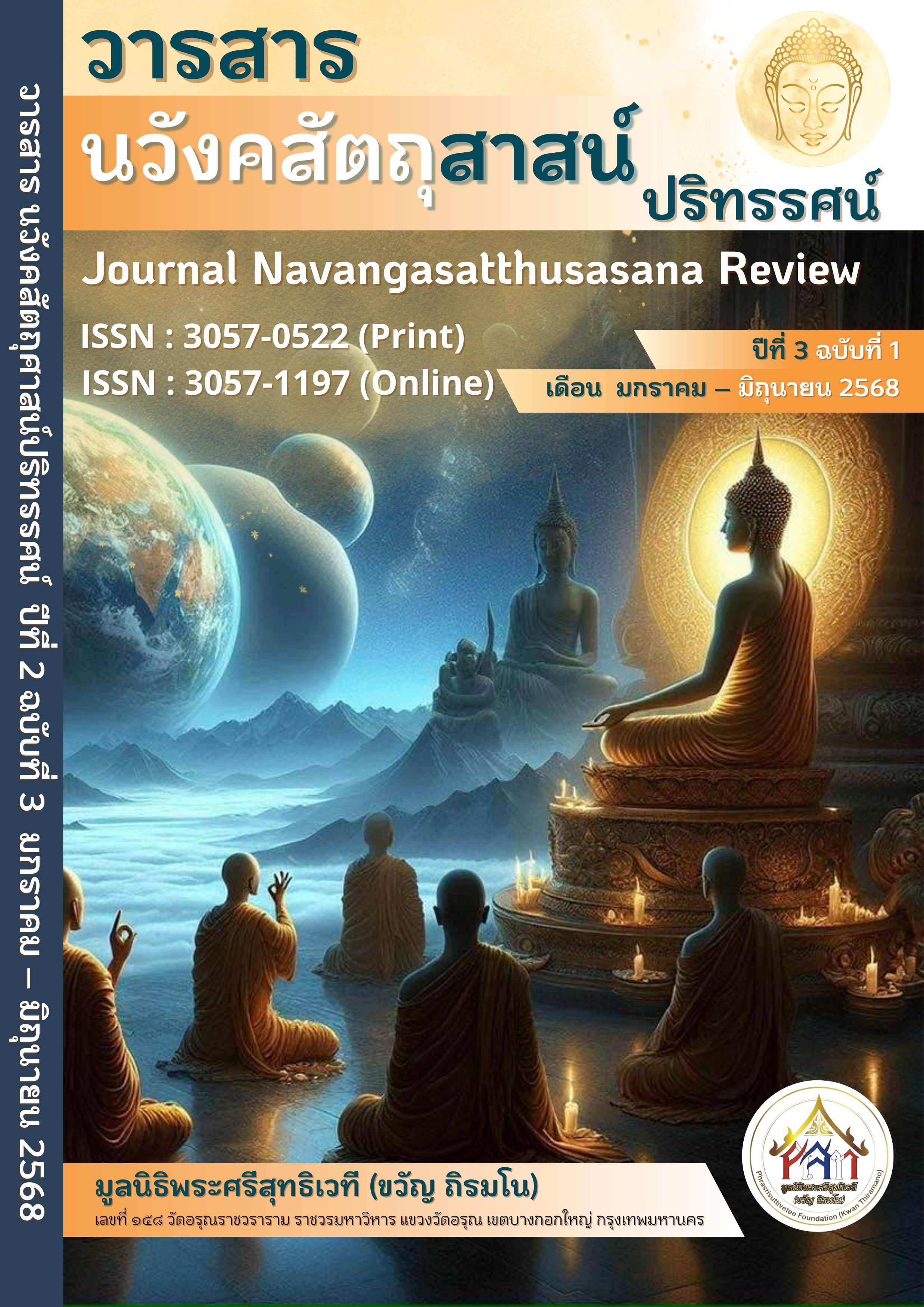Morality on Two Crossroad: A Case of Premature Pregnancy and Abortion in Buddhist View
Main Article Content
Abstract
This article aims at clarifying the problem of premature pregnancy and abortion whether is wrong or acceptable. Abortion is the end of pregnancy before the baby can live outside of mother's womb or ending of pregnancy before 28 weeks. The confusion was that categorical imperative ethics hold such case is wrong without exception. The question raises if in-womb baby was incomplete, sick, probably causing danger and burden to mother after, and child's suffering. With this condition, the categorical imperative view might damage moral itself. Abortion involves with mother who decided to commit the abortion, doctor, supporters or those who are agree with such abortion action, all are considered completely wrong. Moral weakness, parents' lack knowledge and irresponsibility, family planning mistakes are main causes of premature pregnancy in Thailand. The solution, in Buddhism's viewpoint, is middle way, i.e., family should conduct good warm relationship, learning, giving right sexual education to children, immoral media control and encouraging them to follow morality and ethics by implying Buddhist moral teachings such as the five precepts and five moral deeds to abstain from killing, misconduct in sexual relations, maintaining compassion and truthfulness in spouses, including the three training principles, morality, meditation, wisdom, etc.
Article Details

This work is licensed under a Creative Commons Attribution-NonCommercial-NoDerivatives 4.0 International License.
เนื้อหาและข้อมูลในบทความที่ลงตีพิมพ์ในวารสาร นวังคสัตถุสาสน์ปริทรรศน์ถือเป็นข้อคิดเห็นและความรับผิดชอบของผู้เขียนบทความโดยตรงซึ่งกองบรรณาธิการวารสาร ไม่จำเป็นต้องเห็นด้วย หรือร่วมรับผิดชอบใด ๆ บทความ ข้อมูล เนื้อหา รูปภาพ ฯลฯ ที่ได้รับการตีพิมพ์ในวารสาร นวังคสัตถุสาสน์ปริทรรศน์ถือเป็นลิขสิทธิ์ของวารสาร นวังคสัตถุสาสน์ปริทรรศน์หากบุคคลหรือหน่วยงานใดต้องการนำทั้งหมดหรือส่วนหนึ่งส่วนใดไปเผยแพร่ต่อหรือเพื่อกระทำการใด ๆ จะต้องได้รับอนุญาตเป็นลายลักอักษรจากวารสาร นวังคสัตถุสาสน์ปริทรรศน์ก่อนเท่านั้น
References
กฤต ศรียะอาจ. ณัทธีร์ ศรีดี. พระศรีรัตนโมลี. “การศึกษาวิเคราะห์หลักพุทธจริยศสตร์กับการประกอบอสชีพในสมัยพุทธกาล”. วารสารมหาจุฬาวิชาการ. ปีที่ 6. (ฉบับพิเศษ 2019).
การทำแท้งถูกกฎหมาย หนึ่งปัญหาใหญ่ที่ถูกปิดเงียบในสังคม. [ออนไลน์]. แหล่งที่มา: https://sdsybullertin.com /know-agenda-abortion-in-thailand/50062 [20 มกราคม 2565].
ไกรฤกษ์ เกษมสันต์. คำอธิบายประมวลกฎหมายอาญา มาตรา 288 - มาตรา 366. พิมพ์ครั้งที่ 4. (กรุงเทพมหานคร: สำนักอบรมศึกษากฎหมายแห่งเนติบัณฑิตยสภา. 2551).
ขวัญชัย เอกจิตต์ และ อุทัย สติมั่น. “หลักไตรสิกขากับการพัฒนาตน”. วารสารครุศาสตร์ปริทรรศน์ฯ. ปีที่ 3. ฉบับที่ 2. (พฤษภาคม - สิงหาคม 2559).
นายแพทย์วิสูตร ฟองศิริไพบูลย์. พ.บ.. น.บ.ท.. ว.ว.นิติเวชศาสตร์. ภาควิขานิติเวชศาสตร์. คณะแพทยศาสตร์ศิริราชพยาบาล. มหาวิทยาลัยมหิดล. วารสารเวชบันทึกศิริราช นิติเวชกับผู้ป่วย. ปีที่ 1. ฉบับที่ 2. (พฤษภาคม 2551).
ปิยะบุตร แสงกนกกุล. 30 ปี กฎหมายทำแท้งเสรีในฝรั่งเศส. [ออนไลน์]. แหล่งที่มา: www.pub-law.net/publaw/view.aspx?ID=674 [22 พฤศจิกายน 2553].
พระพรหมคุณาภรณ์ (ประยุทธ์ ปยุตฺโต). พุทธธรรม. (กรุงเทพมหานคร: โรงพิมพ์มหาจุฬาลงกรณราชวิทยาลัย. 2555).
ไพฑูรย์ สวนมะไฟ และ อุทัย สติมั่น. “การทำแท้ง: วิกฤตของพุทธจริยธรรมในสังคมไทย”. วารสารนวัตกรรมการศึกษาและการวิจัย. ปีที่ 1. ฉบับที่ 3. (กันยายน – ธันวาคม 2560).
ไพฑูรย์ สวนมะไฟ และ อุทัย สติมั่น. “การทำแท้ง: วิกฤติของพุทธจริยธรรมในสังคมไทย”. วารสารนวัตกรรมการศึกษาและการวิจัย. ปีที่ 1. ฉบับที่ 3. (กันยายน - ธันวาคม 2560).
มหาจุฬาลงกรณราชวิทยาลัย. พระไตรปิฎกภาษาไทย ฉบับมหาจุฬาลงกรณราชวิทยาลัย. กรุงเทพมหานคร: โรงพิมพ์มหาจุฬาลงกรณราชวิทยาลัย. 2539.
สังข์วาล เสริมแก้ว. เอกสารประกอบการสอนวิชาสัมมนาพระพุทธศาสนา. (เอกสารอัดสำเนา. 2564).
Grimes. DA; Stuart. G (2010). “Abortion jabberwocky: the need for bettertemino logy”. Contraception. 81 (2).
Mahachulalongkornrajavidyalaya University. Sutta pitaka majihima nikaya ska Vol. 12 Bangkok: University; 1996. (in Thai).
Schorge. John O.; Schaffer. Joseph l.; Halvorson. Lisa M.; Hoffman. Barbara L; Bradshaw. Karen D.; Cunningham. F. Gary. บ.ก. (2008). “6. First-Trimester Abortion”. Williams Gynecology (1 ed.). McGraw-Hill Medical ISBN 998-0-07-147257-9.
Sedgh. G; Singh. Shah. I. H.; “Ahman. E.; Henshaw. S. K; Bankole. A (2012) “induced abortion:Incidence and trends worldwide from 1995 to 2008” (PDF). The Lancet. 379 (9816).


